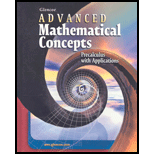
Concept explainers
(a)
To find: The sum of the wages in each class.
(a)
Answer to Problem 21E
The sum of wages in each class.
Explanation of Solution
Given:
The given table is as:
| Weekly Wages | Frequency |
Calculation:
The sum is calculated as:
Multiply the average weekly wage by the frequency to obtain the sum of all wages for each class.
Further simplified as:
The sum of wages in each class.
(b)
To find: The sum of all of the wages in the frequency distribution.
(b)
Answer to Problem 21E
The sum of all of the wages in the frequency distribution is
Explanation of Solution
Sum the wages for each class to determine the total amount paid out in wages weekly.
The sum of all of the wages in the frequency distribution is
(c)
To find: The number of employees in the frequency distribution.
(c)
Answer to Problem 21E
The number of employees in the frequency distributionis
Explanation of Solution
Sum the number of workers in each class together to determine the total number of workers:
The number of employees in the frequency distribution is
(d)
To find: The mean weekly wage in the frequency distribution.
(d)
Answer to Problem 21E
The mean weekly wage in the frequency distribution is
Explanation of Solution
The mean is calculated as:
The mean weekly wage in the frequency distribution is
(e)
To find: The median class of the frequency distribution.
(e)
Answer to Problem 21E
The median class of the frequency distributionis
Explanation of Solution
Since there are one hundred employees, if the data is arranged sequentially according to weekly wages, the median would be average of the 50 and 51st value,both of which fall into the
The median class of the frequency distribution is
(f)
To find: The median weekly wage in the frequency distribution.
(f)
Answer to Problem 21E
The median class of the frequency distribution is
Explanation of Solution
Since there are one hundred employees, if the data is arranged sequentially according to weekly wages, the median would be average of the 50 and 51st value, both of which fall into the
The median class of the frequency distribution is
So the median weekly wage in the frequency distribution is:
The median weekly wage in the frequency distribution is
(g)
To explain: The reason of mean and median are good measures of central tendency in this situation.
(g)
Answer to Problem 21E
The reason is given below.
Explanation of Solution
Both the mean and median are good measures of central tendency in this situation because of their similarity in value. Both can be taken as a valid measure of central tendency.
The explanation is given above.
Chapter 14 Solutions
Advanced Mathematical Concepts: Precalculus with Applications, Student Edition
Additional Math Textbook Solutions
Calculus: Early Transcendentals (2nd Edition)
Calculus and Its Applications (11th Edition)
Single Variable Calculus: Early Transcendentals (2nd Edition) - Standalone book
University Calculus: Early Transcendentals (4th Edition)
Thomas' Calculus: Early Transcendentals (14th Edition)
 Calculus: Early TranscendentalsCalculusISBN:9781285741550Author:James StewartPublisher:Cengage Learning
Calculus: Early TranscendentalsCalculusISBN:9781285741550Author:James StewartPublisher:Cengage Learning Thomas' Calculus (14th Edition)CalculusISBN:9780134438986Author:Joel R. Hass, Christopher E. Heil, Maurice D. WeirPublisher:PEARSON
Thomas' Calculus (14th Edition)CalculusISBN:9780134438986Author:Joel R. Hass, Christopher E. Heil, Maurice D. WeirPublisher:PEARSON Calculus: Early Transcendentals (3rd Edition)CalculusISBN:9780134763644Author:William L. Briggs, Lyle Cochran, Bernard Gillett, Eric SchulzPublisher:PEARSON
Calculus: Early Transcendentals (3rd Edition)CalculusISBN:9780134763644Author:William L. Briggs, Lyle Cochran, Bernard Gillett, Eric SchulzPublisher:PEARSON Calculus: Early TranscendentalsCalculusISBN:9781319050740Author:Jon Rogawski, Colin Adams, Robert FranzosaPublisher:W. H. Freeman
Calculus: Early TranscendentalsCalculusISBN:9781319050740Author:Jon Rogawski, Colin Adams, Robert FranzosaPublisher:W. H. Freeman
 Calculus: Early Transcendental FunctionsCalculusISBN:9781337552516Author:Ron Larson, Bruce H. EdwardsPublisher:Cengage Learning
Calculus: Early Transcendental FunctionsCalculusISBN:9781337552516Author:Ron Larson, Bruce H. EdwardsPublisher:Cengage Learning





